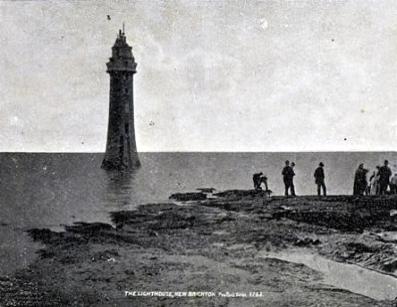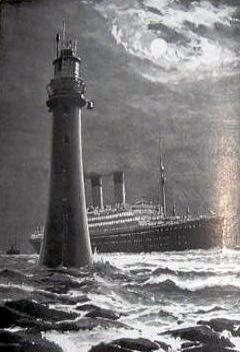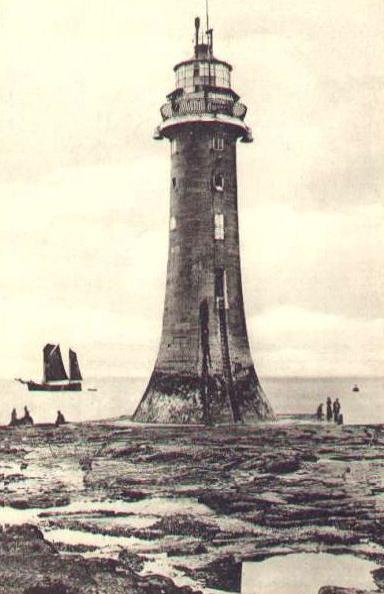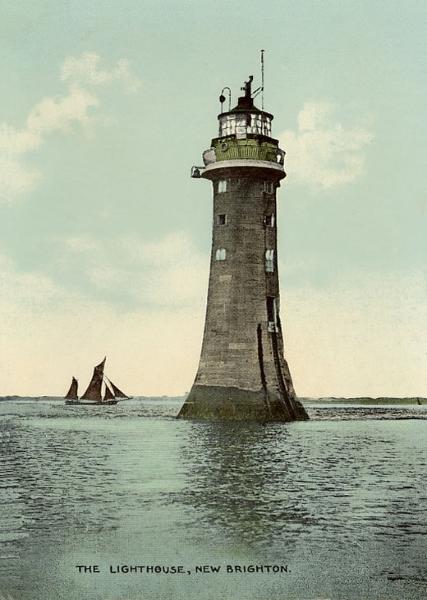New Brighton Lighthouse
To understand the history of Perch Rock Lighthouse we must first understand the nature and history of Maritime To
understand the history of Perch Rock Lighthouse we must first understand the nature and history of Maritime activity
in the area. Liverpool has always been an extremely busy port since the 17th Century and has always been the
most important port in relation to communication and tradable good to Ireland. As trade routes grew, so too did the
amount of vessels on the sea. The area around the Wirral harbours some extremely dangerous channels for vessels
entering the local docks. For ships entering the port of Liverpool the main area of danger was at the entrance to the
River Mersey after entering the Moreton area lined with rugged rock formations which could only be sen at low tide.
The area to which we refer, was known as Black Rock and was named on maps of the time as the Black Rock
Channel.
Records show that for century's vessels have been dashed against these rocks and many sailors have lost their lives
due to this area. There is also a more speculative side to the Black Rock which is that some people argue that locals
have been involved in deliberate wrecking for the goods from the vessels by giving false signals and deliberately
sending ships into the Rock Channel. Personally i do not believe this as most wrecking was done at Hoylake on the
Hoyle Bank, however i am certain that many ships met their fate here albeit by accident. Due to the treacherous
area the Corporation of Liverpool decided that the rocks should be marked to prevent vessels straying into their
path. In 1683 a large wooden perch was erected in the water as a deterrent for ships coming too close to the area.
The wooden stake could be seen at all times and was a small light which sat on top held by a wooden tripod. Almost
a century later and due to the large increase in shipping through the Liverpool & Wirral area, a number of light
houses were setup as further navigational aids. In 1761 work began on 2 lighthouses in the Moreton area and 2 in
the Hoylake area. A decade later a further lighthouse was built at Bidston to help show the route through the Horse
channel of the North West area of Wirral.
The use of the perch was eventually disbanded in the early 1800s after several vessels had struck the post and due
to poor weather which often swept it away. At this time it was decided that a new lighthouse should be built i the
New Brighton area of the Wirral. Work began on the lighthouse in June 1827 after instructions from Thomas
Littledale the then Mayor of Liverpool. Tomkinson & Company were the company responsible for construction of the
new buildings which included a large sloping base built from marble taken from nearby Anglesey. The building was
then coated with "Puzzellani" which is a volcanic substance from Mount Etna. The properties of Puzzellani are very
curious but make it an ideal product for building in that era. The substance bonds and becomes hard and rock like
with age. From the entrance a spiral staircase leads to lighthouse keepers quarters and another door then takes
you up into the lantern house. The state of the art revolving light on top of the building was recorded as being the
first in the country to use this system as most used combustible devices such as lanterns. Upon its completion in
1830 the lighthouse stood 90 feet above the dangerous rocks and was considered to be the finest in the Wirral at a
cost of £27,500. The first test signal was made on St Davids day on the 1st March 1830 which consisted of two
white flashes quickly followed by one red flash. The light was recorded as being visible from a distance of some 14
miles out. As with all the lighthouse on the Wirral the requirement was eventually not longer viable and with the
introduction of radar and GPS one can understand why. The beacon last shone its light on 1st October 1973 but the
structure still stands today as a reminder of Wirral maritime past.
To understand the history of Perch Rock Lighthouse we must first understand the nature and history of Maritime To
understand the history of Perch Rock Lighthouse we must first understand the nature and history of Maritime activity
in the area. Liverpool has always been an extremely busy port since the 17th Century and has always been the
most important port in relation to communication and tradable good to Ireland. As trade routes grew, so too did the
amount of vessels on the sea. The area around the Wirral harbours some extremely dangerous channels for vessels
entering the local docks. For ships entering the port of Liverpool the main area of danger was at the entrance to the
River Mersey after entering the Moreton area lined with rugged rock formations which could only be sen at low tide.
The area to which we refer, was known as Black Rock and was named on maps of the time as the Black Rock
Channel.
Records show that for century's vessels have been dashed against these rocks and many sailors have lost their lives
due to this area. There is also a more speculative side to the Black Rock which is that some people argue that locals
have been involved in deliberate wrecking for the goods from the vessels by giving false signals and deliberately
sending ships into the Rock Channel. Personally i do not believe this as most wrecking was done at Hoylake on the
Hoyle Bank, however i am certain that many ships met their fate here albeit by accident. Due to the treacherous
area the Corporation of Liverpool decided that the rocks should be marked to prevent vessels straying into their
path. In 1683 a large wooden perch was erected in the water as a deterrent for ships coming too close to the area.
The wooden stake could be seen at all times and was a small light which sat on top held by a wooden tripod. Almost
a century later and due to the large increase in shipping through the Liverpool & Wirral area, a number of light
houses were setup as further navigational aids. In 1761 work began on 2 lighthouses in the Moreton area and 2 in
the Hoylake area. A decade later a further lighthouse was built at Bidston to help show the route through the Horse
channel of the North West area of Wirral.
The use of the perch was eventually disbanded in the early 1800s after several vessels had struck the post and due
to poor weather which often swept it away. At this time it was decided that a new lighthouse should be built i the
New Brighton area of the Wirral. Work began on the lighthouse in June 1827 after instructions from Thomas
Littledale the then Mayor of Liverpool. Tomkinson & Company were the company responsible for construction of the
new buildings which included a large sloping base built from marble taken from nearby Anglesey. The building was
then coated with "Puzzellani" which is a volcanic substance from Mount Etna. The properties of Puzzellani are very
curious but make it an ideal product for building in that era. The substance bonds and becomes hard and rock like
with age. From the entrance a spiral staircase leads to lighthouse keepers quarters and another door then takes
you up into the lantern house. The state of the art revolving light on top of the building was recorded as being the
first in the country to use this system as most used combustible devices such as lanterns. Upon its completion in
1830 the lighthouse stood 90 feet above the dangerous rocks and was considered to be the finest in the Wirral at a
cost of £27,500. The first test signal was made on St Davids day on the 1st March 1830 which consisted of two
white flashes quickly followed by one red flash. The light was recorded as being visible from a distance of some 14
miles out. As with all the lighthouse on the Wirral the requirement was eventually not longer viable and with the
introduction of radar and GPS one can understand why. The beacon last shone its light on 1st October 1973 but the
structure still stands today as a reminder of Wirral maritime past.
| The Lighthouse 1931 |
| The Lighthouse at night |








| The Lighthouse at low tide |
| The Lighthouse in 1906 |
| The Lighthouse in 1919 |



| MENU |
